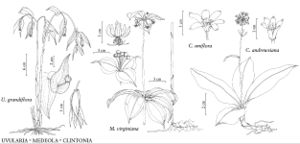Medeola
Sp. Pl. 1: 339. 1753.
Gen. Pl. ed. 5, 158. 1754.
| Taxon | Illustrator ⠉ | |
|---|---|---|
 | Uvularia grandiflora Medeola virginiana Clintonia uniflora Clintonia andrewsiana | Barbara Alongi Yevonn Wilson-Ramsey Yevonn Wilson-Ramsey Yevonn Wilson-Ramsey |
Herbs, perennial, from tapered, white, tuberlike, horizontal rhizomes. Stems simple, slender. Leaves in 2 whorls; proximal blades oblong-oblanceolate, base attenuate, margins entire, apex acuminate; distal blades ovate, rounded at base, apex acuminate. Inflorescences terminal, umbellate, (2–) 3–9-flowered, sessile. Flowers: tepals caducous, 6, similar, recurved, distinct; stamens 6; anthers versatile, oblong, extrorse; ovary superior, 3-locular; styles 3, recurved, distinct to base, often purple; pedicel declined or spreading in flower, erect in fruit. Fruits baccate, dark purple to black, globose. Seeds few, shiny brown, subglobose. x = 7.
Distribution
e North America
Discussion
Species 1.
Medeola was removed from its long association with Trillium and Paris (tribe Parideae) when A. L. Takhtajan (1987, 1997) created the monotypic Medeolaceae, placing it next to a strictly defined Liliaceae. M. N. Tamura (1998c) included Medeola and Clintonia in the tribe Medeoloideae within a narrowly defined Liliaceae. The association of Medeola and Clintonia is supported by molecular analysis (K. Hayashi et al. 1998, 2001; T. B. Patterson and T. J. Givnish 1998) as well as morphology (R. Y. Berg 1962; M. Takahashi 1984; F. H. Utech 1978e), embryology (R. Y. Berg 1962b), and cytology (R. M. Stewart and R. Bamford 1942; M. N. Tamura 1995).
Selected References
None.
Lower Taxa
"broad" is not a number."thicker" is not a number.